Physical Address
304 North Cardinal St.
Dorchester Center, MA 02124
“CONCLUSIONS: Much of what has been written in this chapter may soon be outdated.” James Strickland
Acknowledgments: The visionary capacity of Dr. Strickland is mesmerizing. In 1982 in the very first edition of this book, he wrote that microsurgery would change the rules on thumb reconstruction. I became fascinated when I read that chapter as a resident, and I still am, having reviewed all the different editions since. Much has changed, but all the principles of thumb reconstruction were in Dr Strickland’s very first edition. My intention here is to write an updated version from the perspective of a microsurgeon, fully aware that those principles still hold true. The chapter is dedicated to my bosses Prof. Ian Taylor, Dr. Kleinert, Dr. Scheker, and finally, Dr. Ian Jackson. This outstanding craniofacial surgeon at the Mayo Clinic did not teach me hand surgery, but I am grateful to him for showing the importance of excellence. I would also like to acknowledge Dr. Strickland and the authors of previous editions of this chapter: Drs. Kleinmann, Lee, and Azari.
The thumb is the most important digit, and its loss causes up to 40% impairment of the hand. There are many things that a surgeon should know about the beauty of this most crucial digit. However, as this book is eminently surgical, and my space is limited, the discussion of this chapter is orientated to surgery and reconstruction of the thumb. I have divided it into four parts: terminal defects, central defects, first web problems, and the management of devastating injuries. The aim is to give the reader an idea of how to approach an injured thumb.
The first consideration at the time of reconstruction is to set what we want to accomplish. The response is obvious, a normal thumb, and we should stress that there is nothing like the original thumb. Not surprisingly, Haas et al. evaluated long-term subjective and functional scores of thumb replantation and found that no reconstructive procedure could be compared with a successful replantation. They underlined that it is mandatory to attempt replantation in every amputation. However, reconstruction is many times necessary. Littler, while writing about the thumb reconstruction has said that “it is not on the length, strength or mobility of the thumb but on the strategic position of the thumb and the sensation of the fingertip where rests the power of the human hand.” This axiom is very true for proximal amputations, as we will discuss later, but without doubt the most important issue we should consider is to provide a thumb without pain. If the thumb is painful, the patient will not use it no matter how perfect it may appear. Similarly, the length is also important: a short thumb will have difficulties grabbing large objects and picking up smaller ones. When set by the side of the index, the ideal thumb is about 0.5 cm shorter than the proximal interphalangeal (PIP) joint of the index. Longer thumbs will look grotesque. By the same token, the surgeon should strive for a shorter thumb when the other digits are missing to make it possible to oppose with them. Shorter thumbs are also preferred when the joints are stiff, as the neo-thumb will be more exposed to trauma when making a fist.
Before starting to manage any thumb injury, it is worth stressing the importance of not adding scars that may hinder the definitive reconstruction. If the surgeon is unsure about what to offer, the wisest thing is to clean the wound and debride devitalized tissues and send the patient to a specialized center. One should avoid any attempt at primary closure if this implies sacrificing important tissue, particularly functioning joints. If this is not feasible, a good alternative is to cover the stump with a pedicled groin flap or another flap , as this will prevent the sacrifice of structures that may be crucial for a latter reconstruction and will give time for proper planning.
In the literature there are a myriad of procedures dealing with thumb reconstruction, but before a method is selected, the surgeon should consider the obvious: what the patient’s needs and wishes are, if the patient is fit for a long operative procedure, and if the surgeon is competent to provide what is needed. Some of the procedures discussed in this chapter rank highly in terms of complexity and are thus risky, while others are more accessible to all of us and therefore safe. Through the years I have seen that the main reason for failure is due to attempting to do too much, that is, searching for the ideal when you are not prepared to do so. So, if I can give a piece of advice, it would be this: do not set too high a goal for your reconstruction. A successful reconstruction will spur you on to go for more, and the contrary will occur if you fail. On the other hand, there will be surgeons who are so skilled that they will find even the more complex reconstructions presented here too easy. In my defense, this book is targeted at beginners and those with limited experience. Too much philosophy, and I have just said this was not my intention. Let’s get down to work!
There are many classifications available describing the different levels of amputation: Campbell-Reid, Lister, Hentz, and Merle are among the most popular. These classifications are very precise, but the problem is remembering which grade/number corresponds to which level. I must admit that despite being an expert in the matter, to remember them is beyond my mental capacity. Furthermore, none of them includes the important prognostic modifiers for the sake of not becoming overwhelmingly complicated, ending up being useless for correct surgical planning. Dr. Strickland in the first edition of this book used a simple classification, which I will endeavor to stick to ( Fig. 48.1 ), albeit I should stress that it lacks significant prognostic value. Taking all this into account, what I find more useful is to define the exact anatomic location of the amputation. This requires little mental effort and is easily understood by all. However, length is just one important factor in choosing an option for reconstruction, and the surgeon should also consider whether there is thenar damage, the quality of the skin, whether the nerves are avulsed, and the functionality of the joints proximal to the amputation. All these facts together will determine the correct surgical choice.
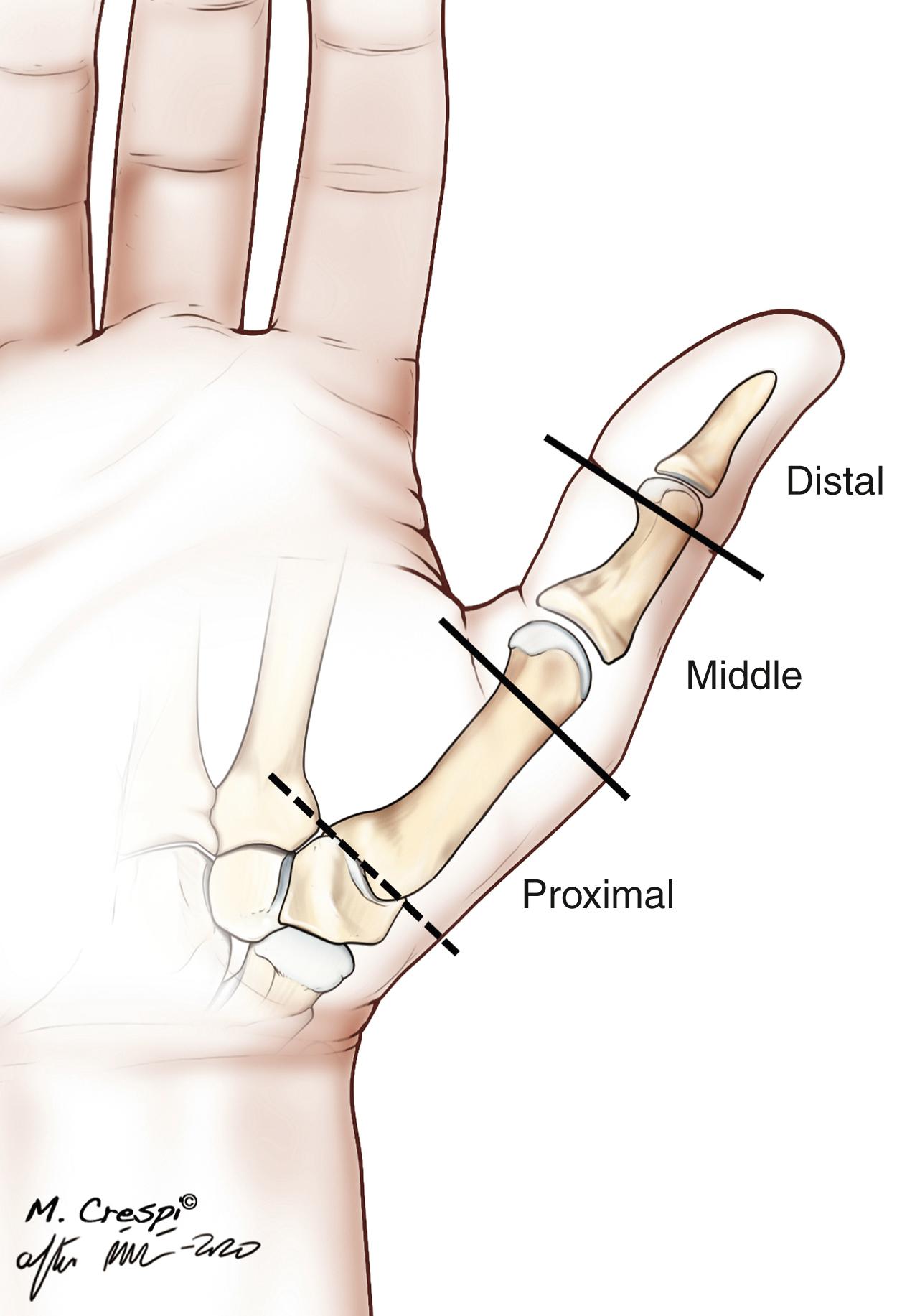
Pulp injuries are extremely common. Preserving length is a priority but the surgeon should also strive to provide a pulp covered with sensitive skin, without scarring and with good cushioning. If the pulp is painful, the patient will skip using the thumb and opt for the homolateral index (as in a cigarette pinching) or simply use the other hand for any delicate activity ( Fig. 48.2 ).
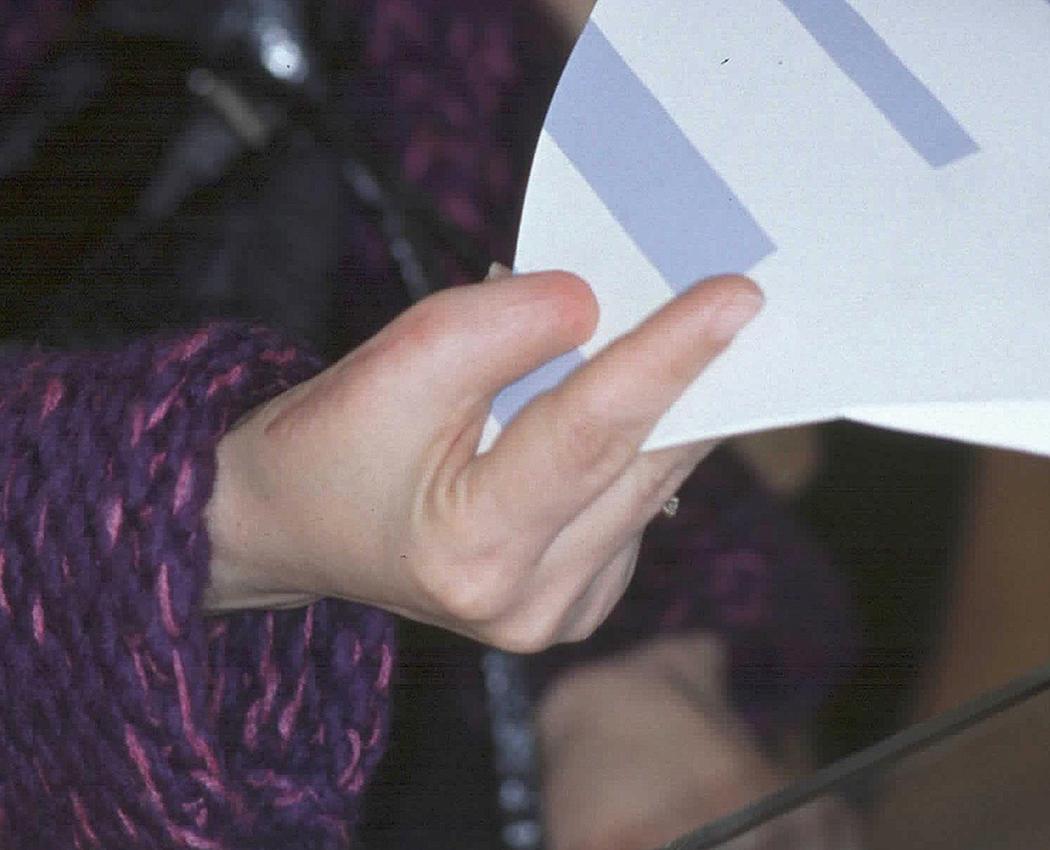
Immediate coverage of the wound has the highest priority to prevent further tissue desiccation and length loss. In recent years we have witnessed considerable advances in flap design, owing to better understanding of the blood supply to the thumb. This has led to cross-finger flaps and many distant flaps being either reserved for extreme situations or plainly discarded, and thus they will not be discussed here. Below, we will deal with the most effective local flaps for these defects.
Moberg described a flap based on both proper neurovascular bundles for coverage of palmar defects of the pulp. The flap permits coverage of moderate-sized defects, providing at the same time sensitive skin.
The flap is elevated under tourniquet. Midaxial incisions are made over the radial and ulnar sides of the thumb and extended proximally from the lesion to the proximal thumb crease. Placement of the incisions across the dorsal apices of the flexion creases facilitates dissection dorsal to the neurovascular bundles. The palmar flap is carefully dissected from the underlying flexor tendon sheath; the flap should include subcutaneous tissue and both neurovascular bundles ( Fig. 48.3 ). The mobility of the flap is tested by distal traction to determine whether any additional proximal undermining or releases are necessary. If tension is too great and good coverage of the pulp requires more than 45 degrees of flexion of the interphalangeal (IP) joint, transforming the flap into a true island or combing the advancement with a “V-Y” flap or Z-plasty in the lateral incisions can give some extra length.

It is said that defects up to 2 cm (about half the pulp length) can be covered with this flap; however, this is often at the price of causing a flexion contracture of the IP joint that can result in a painful thumb and a beaked nail deformity. Problems will be encountered when asking too much of the flap ( Fig. 48.4 ).
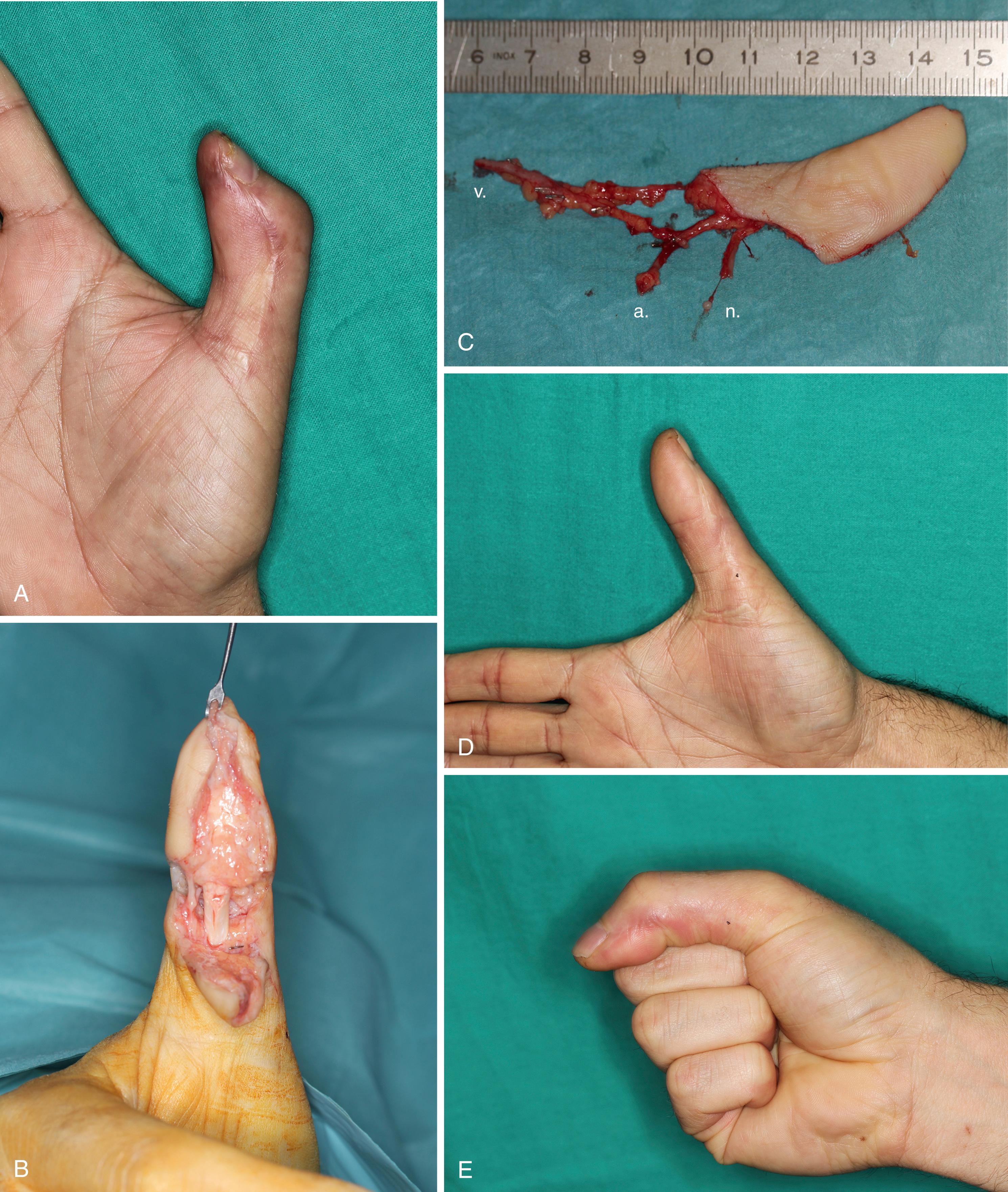
Brunelli et al. , studied the layout of the arteries on the dorsal surface of the thumb. Their constant disposition and anastomoses permitted raising distally based flaps safely from the dorsoulnar region of the metacarpophalangeal joint. ,
This flap is based on the ulnar dorsal digital artery of the thumb, which, as its radial counterpart, has a peculiar anatomy ( Fig. 48.5 ). The artery originates from the palmar digital artery of the thumb at the head of the first metacarpal. The artery continues in the suprafascial layer distally, about 1 cm from the proximal phalanx midline, ending up as a contributor to the nail fold arterial arcade. During its short course, it has two constant anastomoses that allow this flap to rotate in two different spots. The first pivot point is located at the neck of the proximal phalanx (2.5 cm proximal to the cuticle); the second is located at the level of the nail fold arcade (0.9 to 1 cm proximal to the cuticle). While the first point of rotation permits the flap to reach dorsal thumb defects, the distal one allows the flap to cover the pulp and the nail.
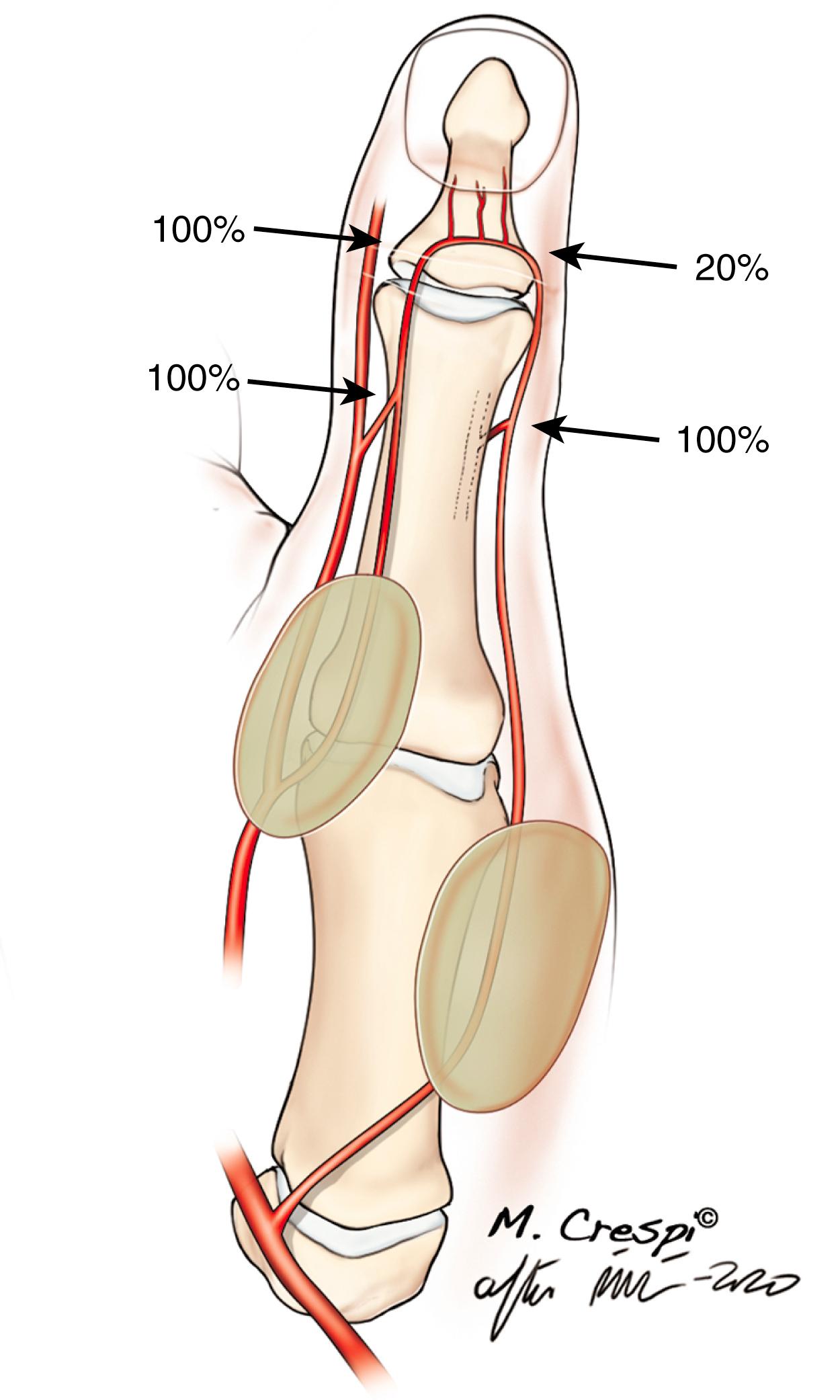
Understanding the anatomy is crucial for safe elevation. In all its path, the artery runs superficially within the subcutaneous tissue, adjacent to the fascia. The flap is outlined on the ulnar surface of the metacarpophalangeal (MCP) joint of the thumb and elevated in a subfascial plane. If necessary, the branch of the radial nerve is identified and dissected proximally for later reconnection. The skin over the pedicle is elevated in a subdermal plane. Then, a generous subcutaneous pedicle about 1 cm wide, including one or two veins, is raised to protect the artery and permit safe outflow. The flap is rotated at the chosen pivot point, taking care to avoid any tension during the rotation process. As venous outflow may be a problem, tight skin closure over the pedicle or tunneling of the flap is currently not recommended. , The ulnar dorsal digital nerve can be included to be coapted to one of the volar digital nerves if necessary.
Several variations of this flap have been presented, including an adipofascial extension to reduce donor site morbidity and the possibility of carrying bone, probably in doubtful conditions. ,
Irrespective of the fact that this flap represents a considerable advance in thumb coverage ( Fig. 48.6 ), and it obviates the need for cross-finger flaps and all two-stage methods, it should, nevertheless, be used with caution. The surgeon should only raise the flap when the area of the cross anastomoses is intact, otherwise arterial failure will occur. Furthermore, the flap suffers from venous congestion if the skin over the pedicle is closed; skin-grafting is thus recommended. , In addition, because the skin at the site of the flap is elevated and is quite loose—nature provided it to permit thumb abduction—the surgeon may be tempted to close primarily excessively large donor sites. This will cause iatrogenic first web contracture and reduced MCP joint motion. Skin grafting is again recommended if large flaps are raised. ,
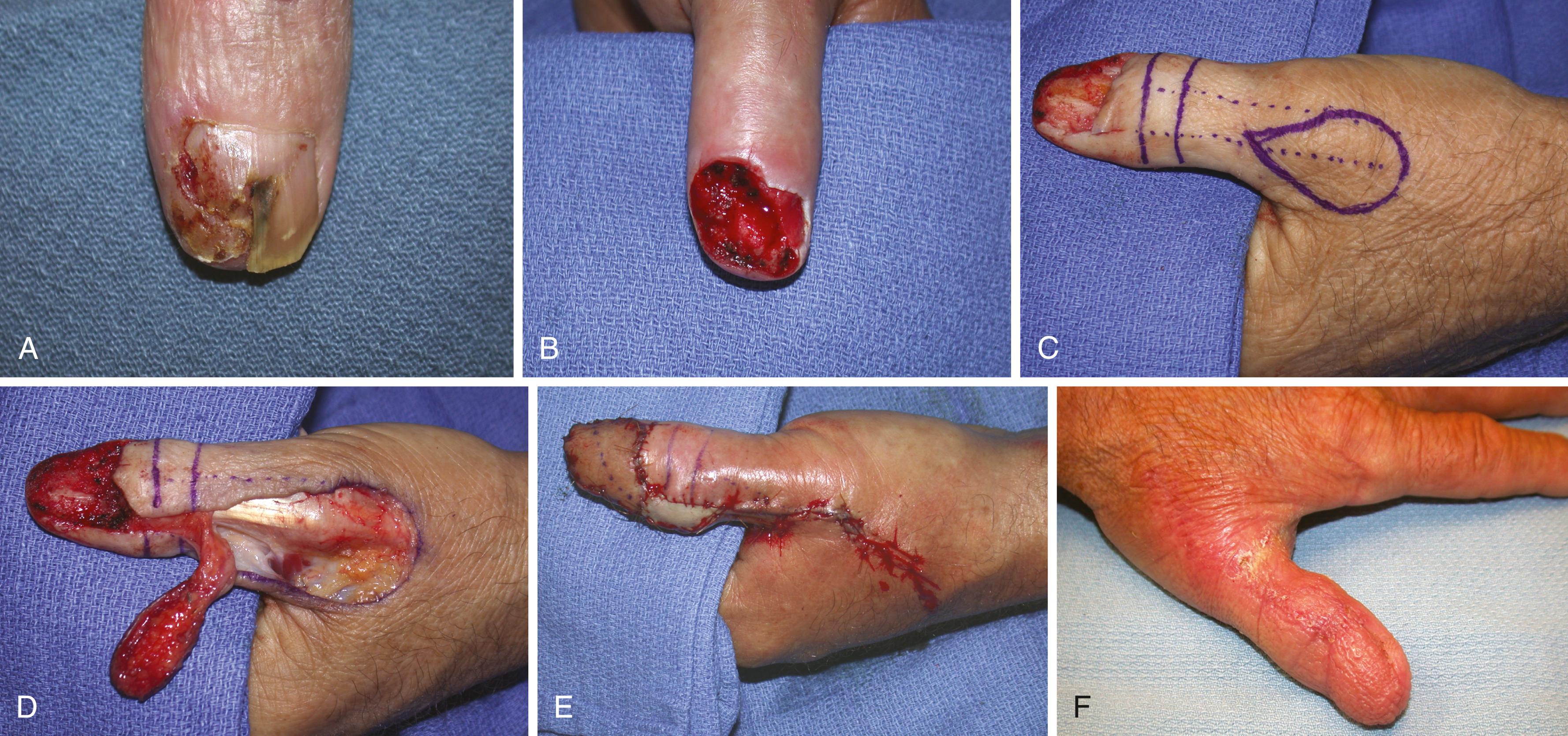
A major drawback of this flap is the lack of sensory recovery, even when the dorsal branch of the radial nerve is connected to the ulnar digital nerve. For this reason, the flap is not recommended when there are defects involving more than 50% of the pulp. However, it may be indicated for larger defects in the elderly, where sensory recovery is frequently poor irrespective of the reconstructive option selected. For these reasons, this flap should probably only be utilized by those with experience in its application.
A similar flap based on the radial dorsal digital artery was described by Moschella and Cordova to solve radial and dorsal thumb defects. ,
This flap’s artery originates from the radial artery itself at the level of the anatomic snuffbox and passes deep to the extensor pollicis brevis tendon. It travels over the proximal phalanx at about 1 cm from the midline in the suprafascial plane. The rotation point of this flap is always the middle of the proximal phalanx. The reason for this is that it has a different arterial communicating pattern than the ulnar counterpart. Indeed, it constantly communicates with the palmar vasculature at the level of the middle third of the proximal phalanx (see Fig. 48.5 ), but the communication with the distal arcade is present in only about 20%.
The skin island to be transferred is drawn on the axis of the artery. The flap can be quite large (up to 3 × 4 cm) and still achieve primary closure, as there is no risk of contracture. As for the dorsoulnar flap, a sufficiently wide strip of subcutaneous tissue must be included in the pedicle. Likewise, visible larger veins should be preserved to secure adequate venous drainage of the flap. Tight closure over the pedicle is to be avoided and skin grafts should be used freely. One recommendation is to add a cutaneous tail to facilitate direct skin closure after rotation of the flap.
Although a branch of the radial nerve can be included and sutured, the originators did not recommend this flap for major pulp defects. Notwithstanding, the flap is a quick and safe solution for many lateral and dorsal defects of the thumb.
One of the most popularly employed procedures for thumb defects is the first dorsal metacarpal artery (FDMA) flap, also known as the “kite flap,” described by Foucher and Braun in 1978. This flap is an evolution of the innervated cross-finger flap described by Hilgenfeldt and refined by Holevich. The flap was devised for dorsal defects and as a vein carrier for thumb replantation. However, the fact that it can include a sensory branch from the radial nerve has made it useful for covering palmar defects, particularly in older people.
The arterial supply of the flap is based on the radial dorsal artery of the index. This branch originates from the FDMA, which takes off from the radial artery between the crossing of the extensor pollicis longus and its penetration into the apex of the first interosseus space.
The radial dorsal artery of the index is constant and travels on top of, or at times in, the aponeurosis of the first dorsal interosseous muscle. After providing a few branches, including one to the joint, the artery terminates supplying vascularity the dorsal skin of the proximal phalanx. There are a number of subcutaneous veins that can be included with the flap and constantly some sensory branches from the radial nerve that end in the proximal phalanx.
A pattern matching the size of the defect is drawn on the dorsum of the index finger proximal phalanx. A lazy “S” incision is performed on a line drawn from the apex of the web to the radial side of the index finger ( Fig. 48.7 ). The flaps are elevated deep to the dermis from side to side, thus keeping the vessels and nerves together in a subcutaneous pedicle. The skin on the dorsum of the proximal phalanx is incised and the flap elevated with care to leave the peritenon in place, otherwise an ungraftable bed will result. The subcutaneous pedicle is raised in a proximal direction to the pivot point in the apex of the web. During the dissection of the pedicle, no attempt must be made to skeletonize the artery, and in fact a strip of fascia of the dorsal interosseus should be included for its protection. Often the vessel can be seen in the undersurface after the flap is fully raised. Once the flap is fully mobilized, it is transposed to the thumb, customarily through a generous subcutaneous tunnel. The flap is sutured in position and the incisions are closed loosely on the dorsum of the hand. The tourniquet is now released. I prefer to assess the vascularity of the flap only after it has been sutured onto its final position. Doing otherwise will not rule out the possibility of later necrosis due to pedicle kinking by a fascial band or constriction in the tunnel. After hemostasis of the bed, a full-thickness skin graft is applied and dressed under a tie-over bolus on the proximal phalanx. I keep this dressing for 7 to 10 days unless drainage or inflammation appear.
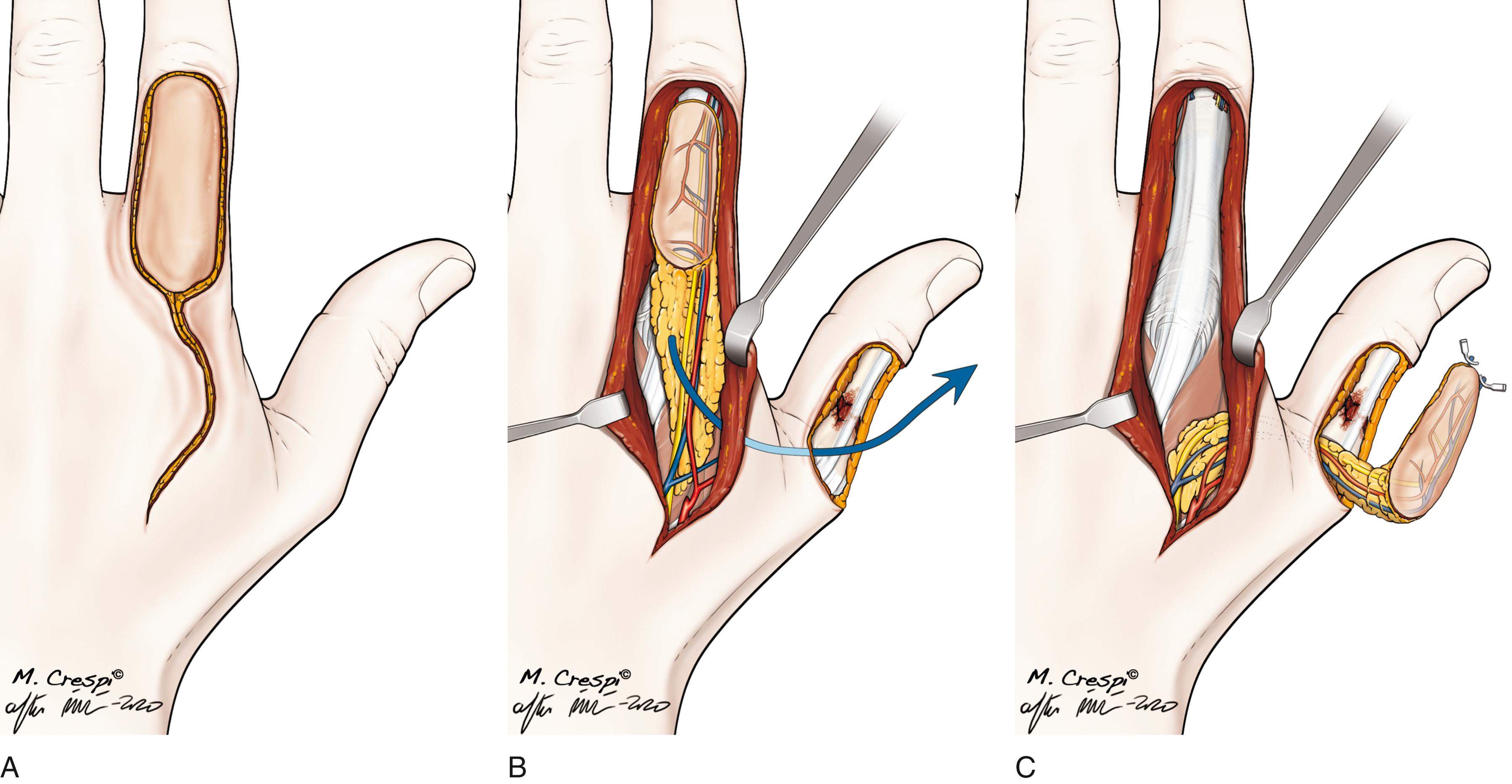
The flap is particularly indicated for dorsal thumb defects. The use of the flap in volar defects is controversial. According to Foucher and Braun, thumb pulp defects “will not be well served” by the kite flap because of the problem of cortical reorientation. Trankle et al., however, found this not to be a problem in their series, and in fact in a later publication the authors consider this flap first choice for thumb pulp defects. Others have applied the kite flap for small defects in the palm or in the first web. ,
I do not consider this flap applicable for pulp defects, but probably it is a suitable indication in older people. The donor site can be (if large) a source of hypertrophic scarring and painful ulcerations. To prevent this from happening the flap should not trespass the MCP or PIP joint creases; furthermore, the peritenon should be left intact. The kite flap plays an indisputable starring role for dorsal thumb defects combined with venous outflow difficulties ( Fig. 48.8 ).
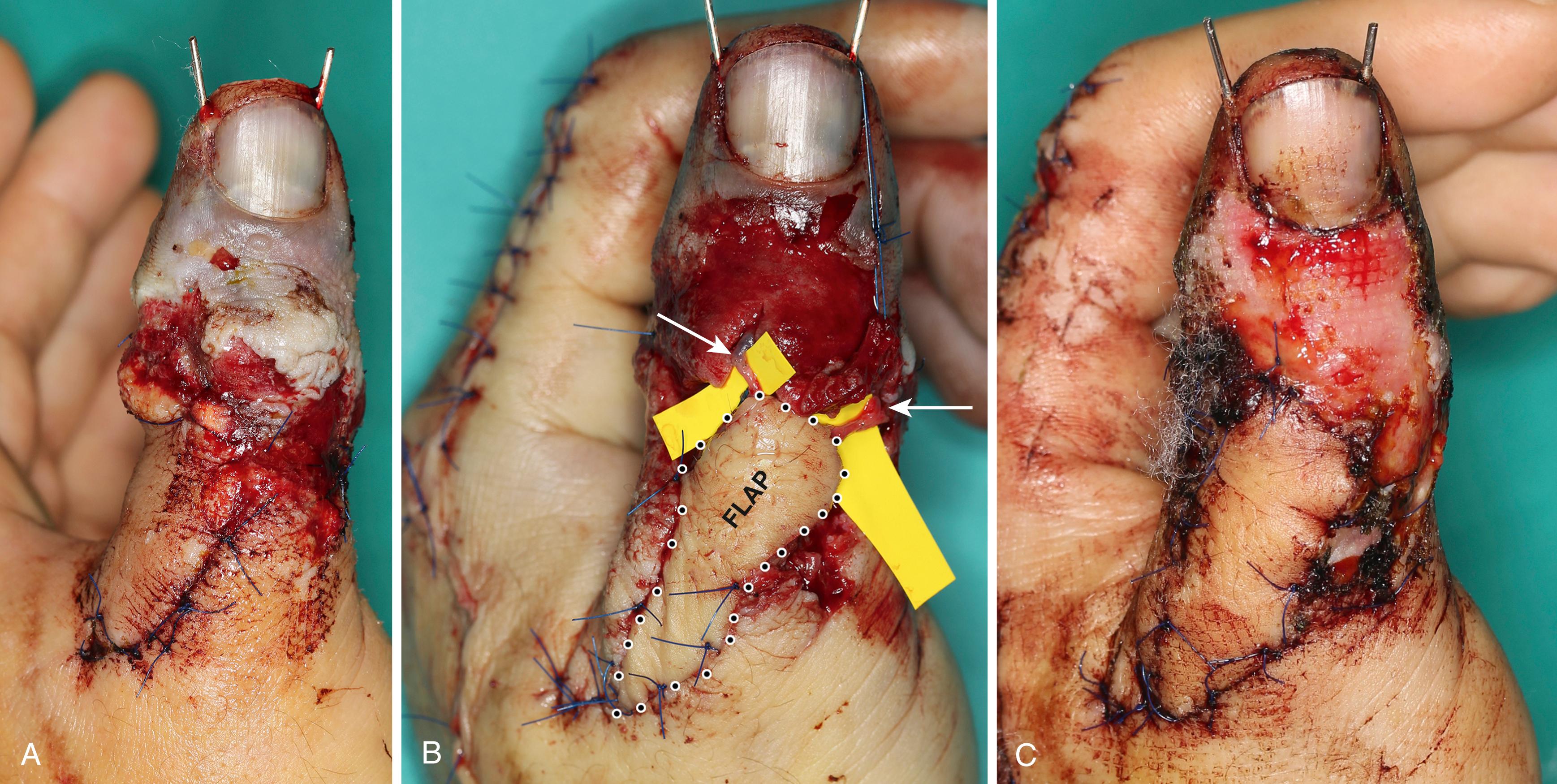
Although in purity the kite flap could also be considered an heterodigital island flap, the name is reserved for the flap described by Littler.
The flap is taken from the ulnar aspect of the middle finger and transposed under a tunnel to the pulp area of the thumb, based on its neurovascular bundle, thus providing sensibility to the pulp. Classically, the flap was the last stage after a neo-thumb reconstruction with a tube flap, usually an osteocutaneous flap from the groin, to provide sensibility to the palmar aspect of the “thumb.” Hence, the technique of raising the extended flap is represented in the books for such an indication ( Fig. 48.9 ).
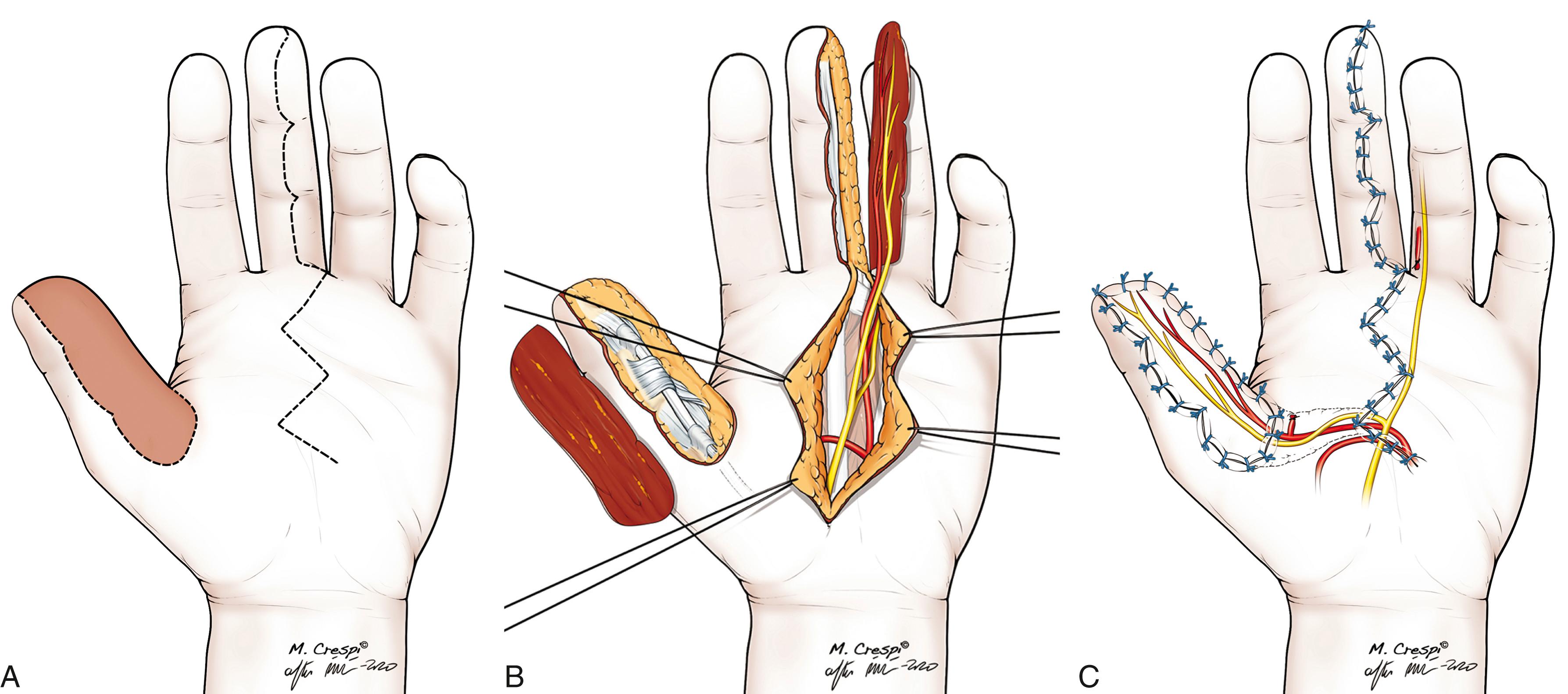
Under tourniquet, the flap is outlined on the ulnar aspect of the middle finger, according to the defect’s needs. Small darts are created at the IP creases, and the flap may extend dorsally beyond the midlateral line of the finger. The neurovascular bundle to the web space is identified by means of a zigzag incision. No attempt is made to skeletonize the artery during the dissection, but on the contrary some fat should be preserved around the pedicle as the venous drainage occurs through minute veins around the artery. The digital artery to the radial side of the ring finger is identified and ligated. The digital nerve to the ring finger is carefully teased apart with microsurgical instruments, well into the midpalm. The artery and nerve to the ulnar side of the donor finger have now been isolated as far as the base of the flap. Incisions are now made around the entire periphery of the flap, until fully islanded in the neurovascular pedicle. During elevation of the flap, utmost care should be taken to preserve the sheath of the flexors and the peritenon of the extensor, as otherwise the bed may not be graftable. The recipient site is prepared to accept the flap that is passed through a generous tunnel. It is recommended to put a suture on the tip of the flap, passing it through the tunnel, and pulling from the other side, sliding the flap under the bridge of the palm. This is a risky maneuver and the author has witnessed the avulsion of the flap from its pedicle while entangled in the tunnel. To prevent this from happening, the tunnel should be made large and the flap, rather than being pulled from the thumb position, should be pushed, with a mosquito, into the thumb’s recipient site. Like any island flap, twisting of the pedicle or tension will not be tolerated. It is thus important to create some redundancy of the pedicle and a generous subcutaneous pocket to prevent tension and, consequently, ensure flap survival.
As for other flaps, the flap is loosely tagged in place, the wounds partly closed, and the tourniquet released. Any bleeders are coagulated, and the vascularity of the flap is assessed. Completion of flap suture and repair of the palmar and proximal digital wounds are carried out at this time. A full-thickness skin graft taken from the medial aspect of the forearm, arm, or groin is sutured onto the donor defect in a tie-over bolus manner. After bandaging, the flap is left exposed for monitoring, and the donor site is left untouched for 7 to 10 days.
The flap is safe and superb in many respects but also has problems and limitations. The most important drawback comes from the fact that this is a sensitive flap, but the nerve is the one of the middle finger. According to Littler, there was no need to connect any nerve, as the patient will learn to reorient the sensibility from the middle finger to the thumb. We, as several others, have found that patients may be permanently disoriented, and might not use the thumb due to this lack of proper sensibility. For this reason, provided there are nerves available, it is wiser to perform a neurorrhaphy between the recipient thumb nerves and the nerve of the flap. , The most common untoward finding after using this flap is flexion contracture of the donor middle finger. This complication is more frequent when a large flap has been raised, the skin graft has not taken well, or poor aftercare. Foam-padded aluminum splints maintaining the PIP joint in extension during nighttime are mandatory to prevent this. Venous problems may occur with the Littler flap, particularly when a large flap has been raised and some fat around the pedicle is not preserved. To avert this, a dorsal vein can be included and connected in the recipient site, but this is not necessary for the standard size flap. If the pedicle is insufficiently dissected, the flap will only reach the thumb with difficulty, potentially causing a painful band across the palm. To prevent this from happening the surgeon has to release the neurovascular pedicle as needed for a tension-free transposition. When facing the problem secondarily, the treatment consists of severing the nerve at the base of the thumb and connecting it to the thumb’s digital nerve. The proximal stump of the middle digital nerve is transposed to the interosseus space. This problem will be exacerbated if the flap is raised from the ulnar side of the ring finger. This later version was recommended to bring sensibility when the median nerve was damaged (an unheard-of situation in the current days of microsurgery). This author has come across, while raising this flap, the setting where the common digital nerve is pierced by the common digital artery (known as Hartmann loop). , In this particular scenario, the nerve, not the artery, should be divided and repaired during the dissection. Doing otherwise will endanger the venous outflow of the flap.
In summary, I find this flap indicated for the patient who has bone exposed and who does not want to have a more complex reconstruction ( Fig. 48.10 ). To avoid cortical disorientation the nerve should be connected to the thumb ulnar digital nerve, and this takes only minimal additional time. If the surgery is planned correctly, the dorsal branch of the digital nerve can be preserved and the proximal stump of the ulnar digital nerve of the middle finger transposed to the intermetacarpal space away from trauma (see Fig. 48.10C ). In my view, another residual indication may be to provide sensation after an osteoplastic reconstruction of a missing thumb. Chen and Noordhoff have raised bilobed flaps for covering large defects but at the price of an excessively high donor site morbidity.
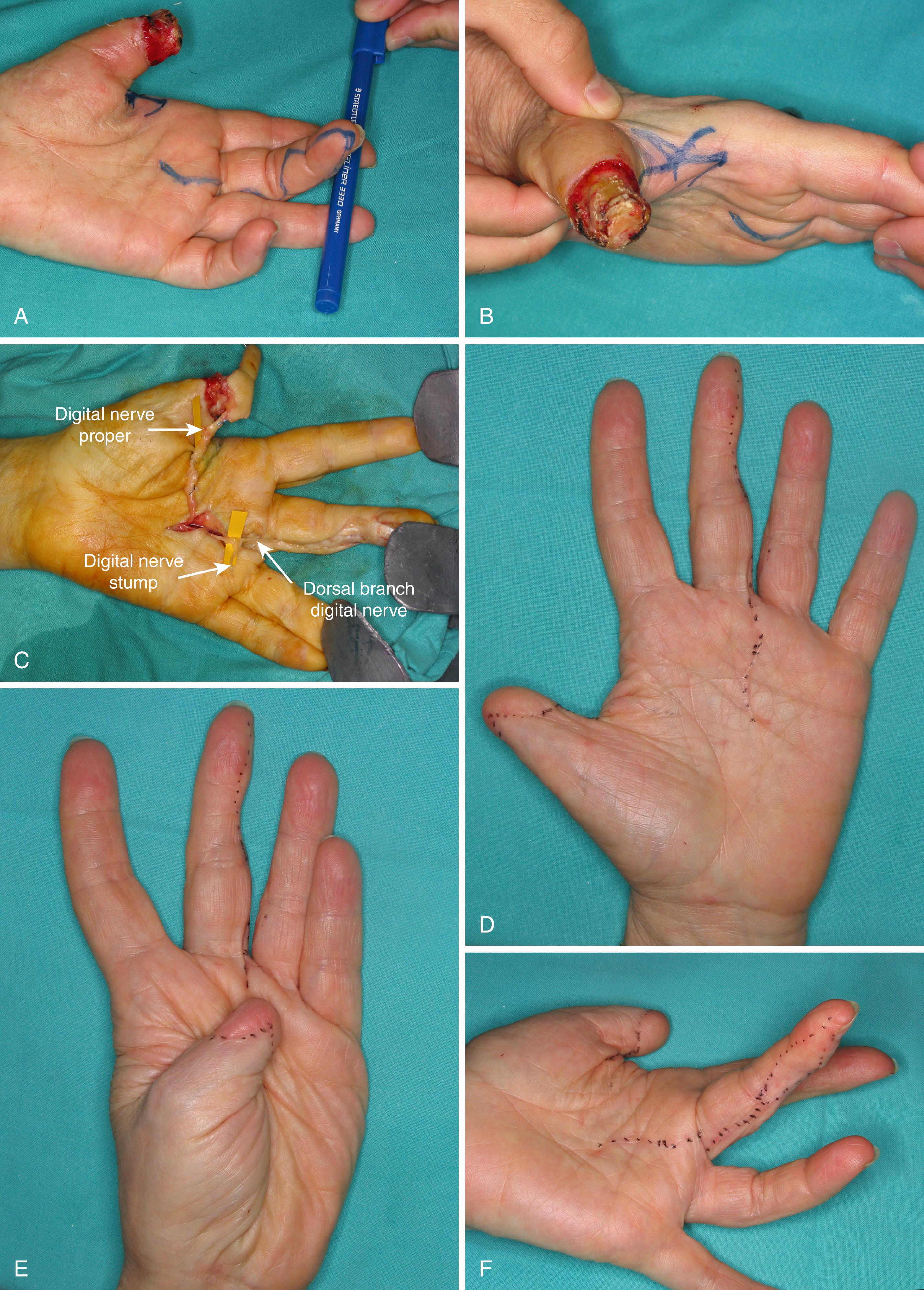
Not only is the nail an important cosmetic element but it also allows us to pick up small objects and offers stability to the pulp when pinching (see Chapter 9 ). Hence, loss of the nail itself may be seen by the patient as an important handicap. Microvascular reconstruction seems to be the only method that produces consistent results.
The problem of nail loss is compounded because it is often associated with bone loss. Hence, a length problem is added to the already functional and cosmetic issue. If the entire sterile matrix is lost the nail will grow short and will lack adherence. Any accidental snagging of the free edge will cause painful lifting of the nail plate. The patient may wish to have the nail removed completely to prevent this from happening. An alternative is to transfer the sterile matrix and the bone from the hallux as a free onycho-osteocutaneous flap. Remarkably, the matrix of the toe will “meld” with the remaining thumb nail ( Fig. 48.11 ). ,
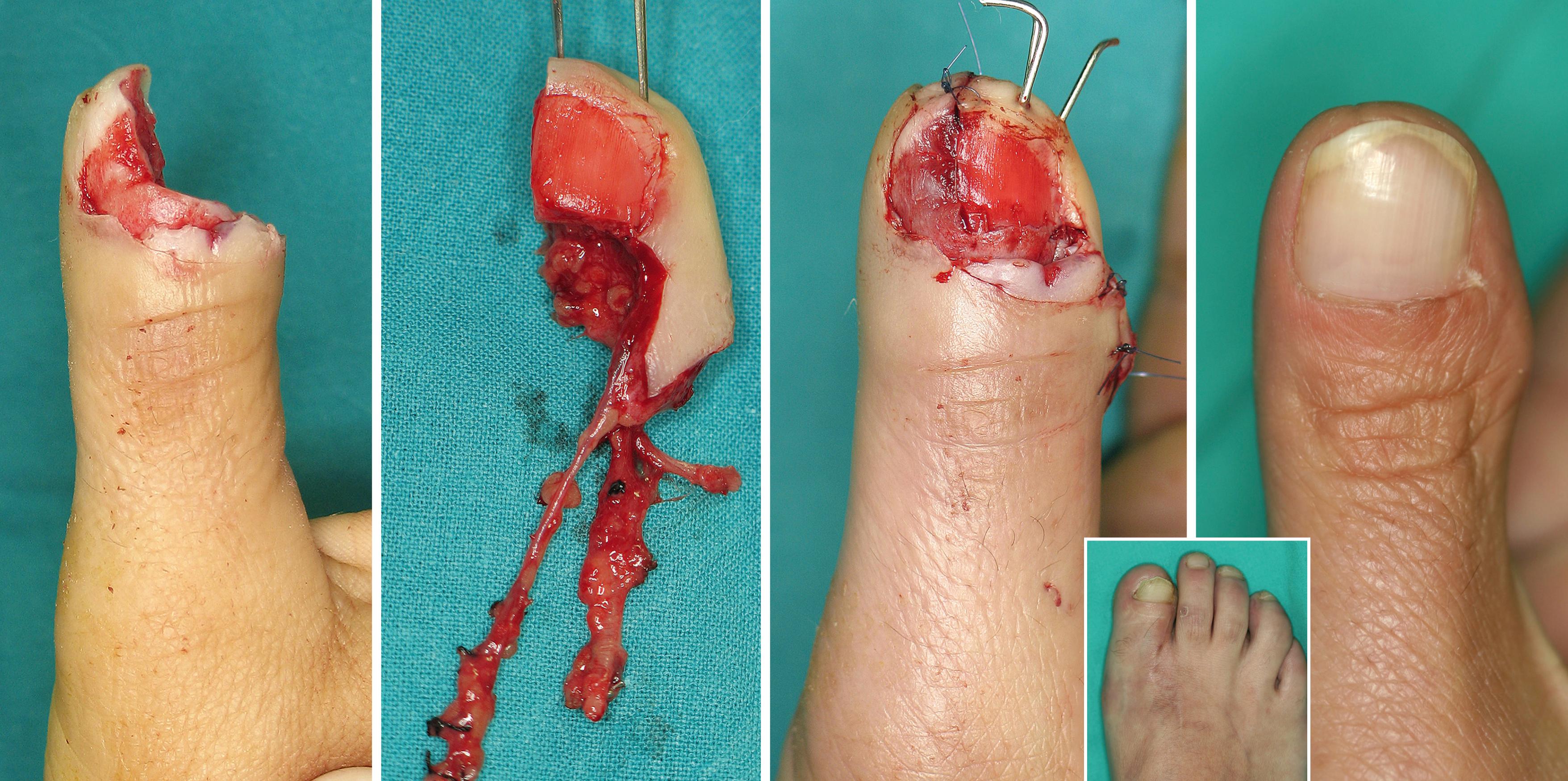
While there are a plethora of papers conceding that functional loss is negligible for amputation distal to the IP joint of the thumb, my experience is radically different. Patients whose thumb is amputated at the distal phalanx perform delicate tasks poorly. They also expressed a deep concern for the cosmetic outcome. Furthermore, the locking effect of the thumb distal phalanx (the so-called vice grip, as termed by Buncke and Valauri) is also lost. Several surgeons have published on the salutary effect of reconstruction of these defects with minimal donor site morbidity at the foot. , ,
Notwithstanding that the technique of great toe dissection is discussed thoroughly in the previous chapter, there are some technical particularities worth emphasizing when dealing with minihallux flaps. The ipsilateral hallux is preferred as this permits the dominant artery and nerve to be oriented along the ulnar side of the thumb. Veins are dissected first, and this is greatly facilitated if there is some blood in the veins; hence, we elevate the tourniquet without applying an Esmarch bandage. The inclusion of the whole nail greatly facilitates harvesting because large dorsal veins forming proximal to the eponychial fold can be included. On the other hand, harvesting a partial nail obliges one to dissect the tiny veins of the lateral aspect of the pulp that are minute, fragile, and easily torn ( Fig. 48.12 ). Regarding arterial inflow, in most cases I only take the peroneal (lateral) digital artery in the first web space. This speeds up harvesting at the price of a smaller vessel for anastomosis. Most importantly, it minimizes donor site morbidity. Utmost care is taken to identify, isolate, and ligate a constant branch proximal to the neck of the proximal phalanx. If this is missed or avulsed, the blood supply to the transfer may be endangered (see Fig. 48.12 , arrow ).
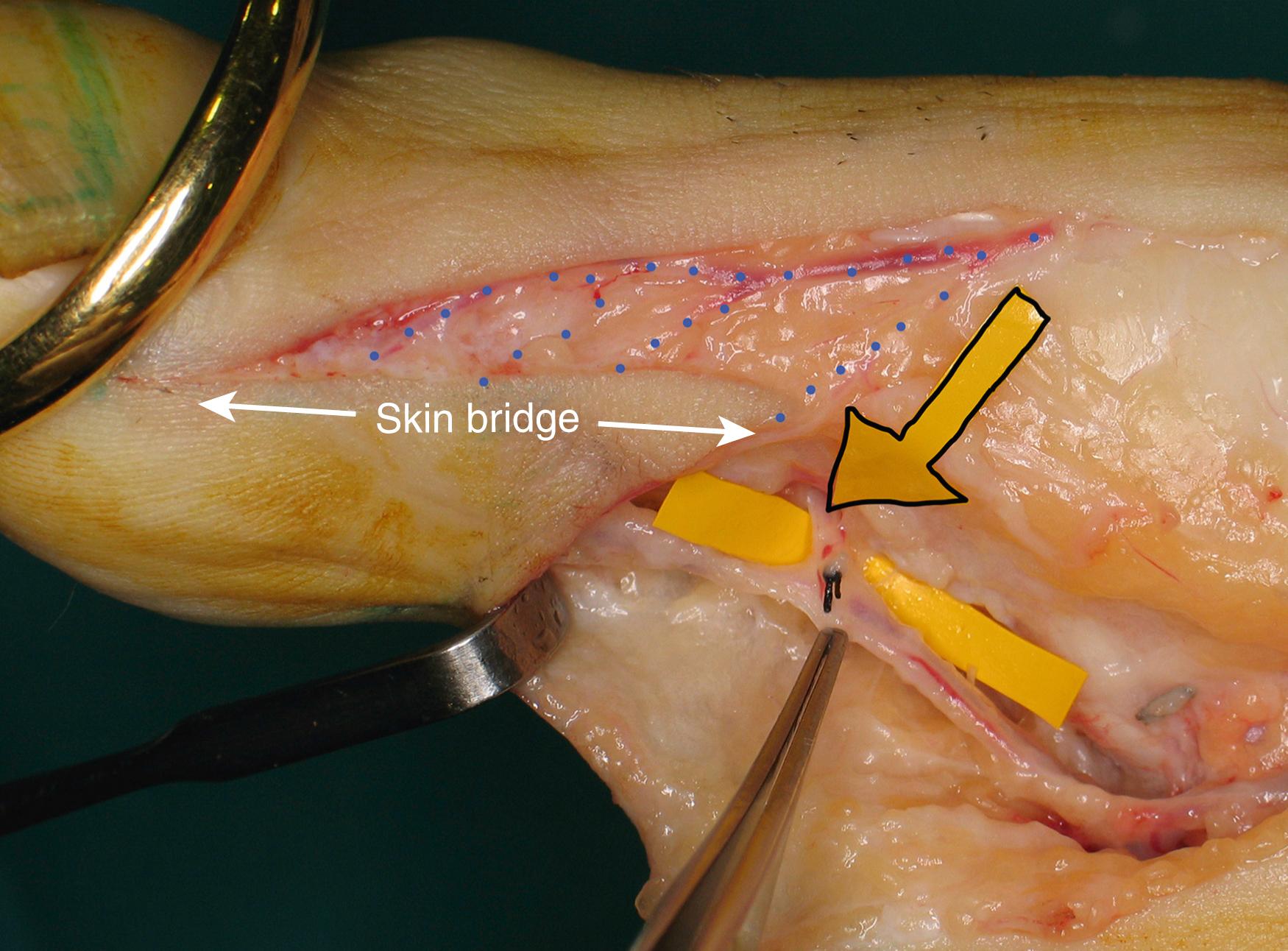
There is no one and only method for solving distal defects. My choice depends on the obliquity, the nail defect, and the amount of missing bone. Of all three factors, the nail is the one that has a higher impact on my decision making ( Fig. 48.13 ; Table 48.1 ).
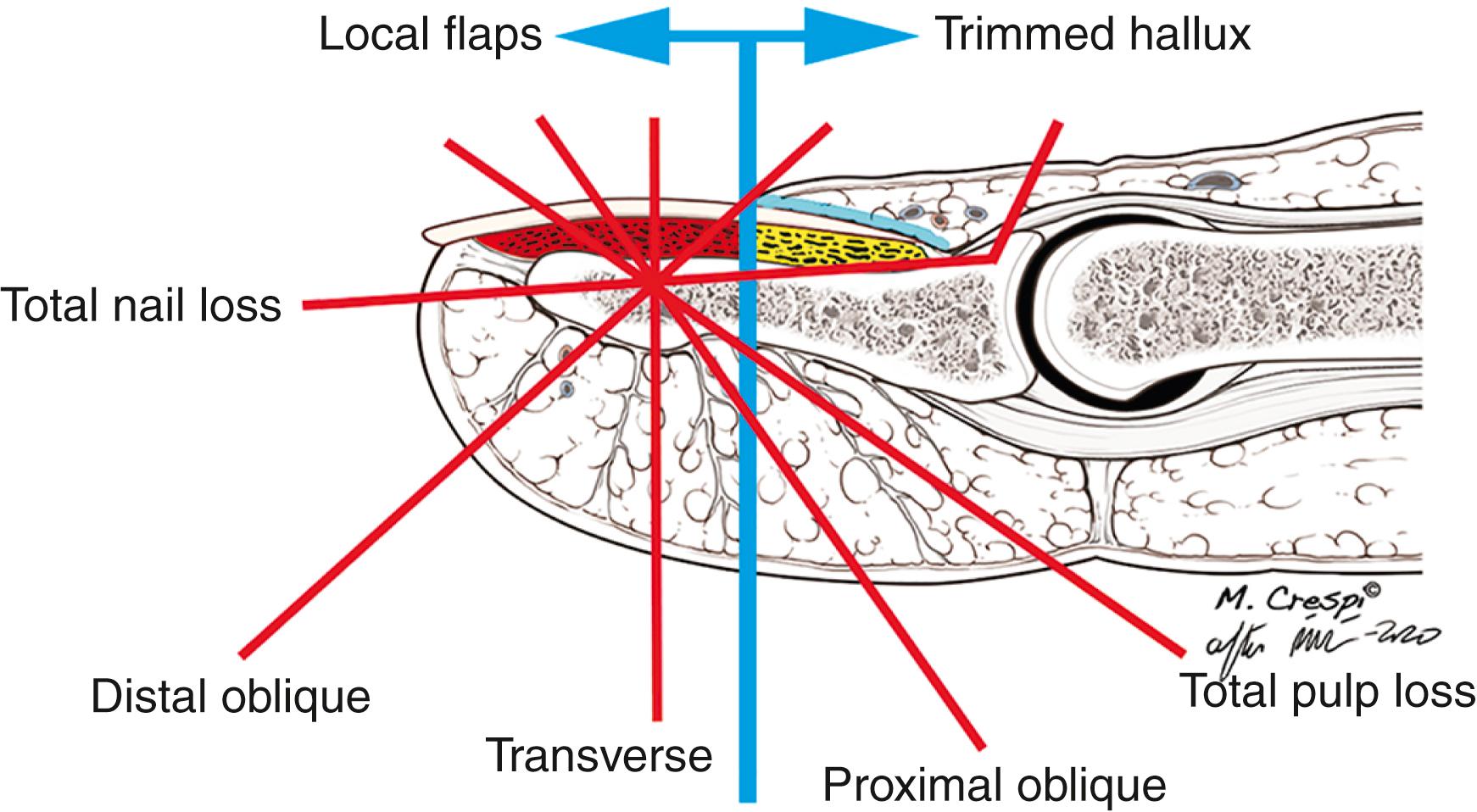
| Nail | Type | 1st Choice | 2nd Choice | 3rd Choice |
|---|---|---|---|---|
| Sterile Matrix Remains | Distal oblique | Secondary healing | Atasoy | – |
| Transverse | Shepard | Atasoy | Moberg | |
| Proximal oblique | Double Shepard | Littler flap | Kite flap | |
| Total pulp loss | Hallux hemipulp | Littler | Kite flap | |
| No Sterile Matrix | Some germinal matrix | Onychoosteocutaneous flap | Nail ablation and flap | Web deepening |
| No germinal matrix | Minihallux | Moschella/Brunelli | As above | |
| Only Nail Missing | Transverse distal | Hallux nail flap | Nail ablation + Moschella | Skin graft |
In the most common type of distal amputation a part of the sterile matrix is still preserved. In these cases, efforts to preserve length and to provide sensitive, nonpainful cover is the goal. For small and moderate pulp defects, without fractures, the conservative approach of Mennen and Wiese is a simple and inexpensive method that can procure miraculous results ( Fig. 48.14 ). The stump is covered with a semiocclusive transparent adhesive dressing after cleaning and debridement, which is changed weekly. The patient is allowed to use the thumb freely. The patient should be warned that the foul odor is normal and of the importance of keeping the dressing in place while the healing process takes place. The wound should heal in around 6 weeks, usually with minimal scarring. Complications are quite unusual.
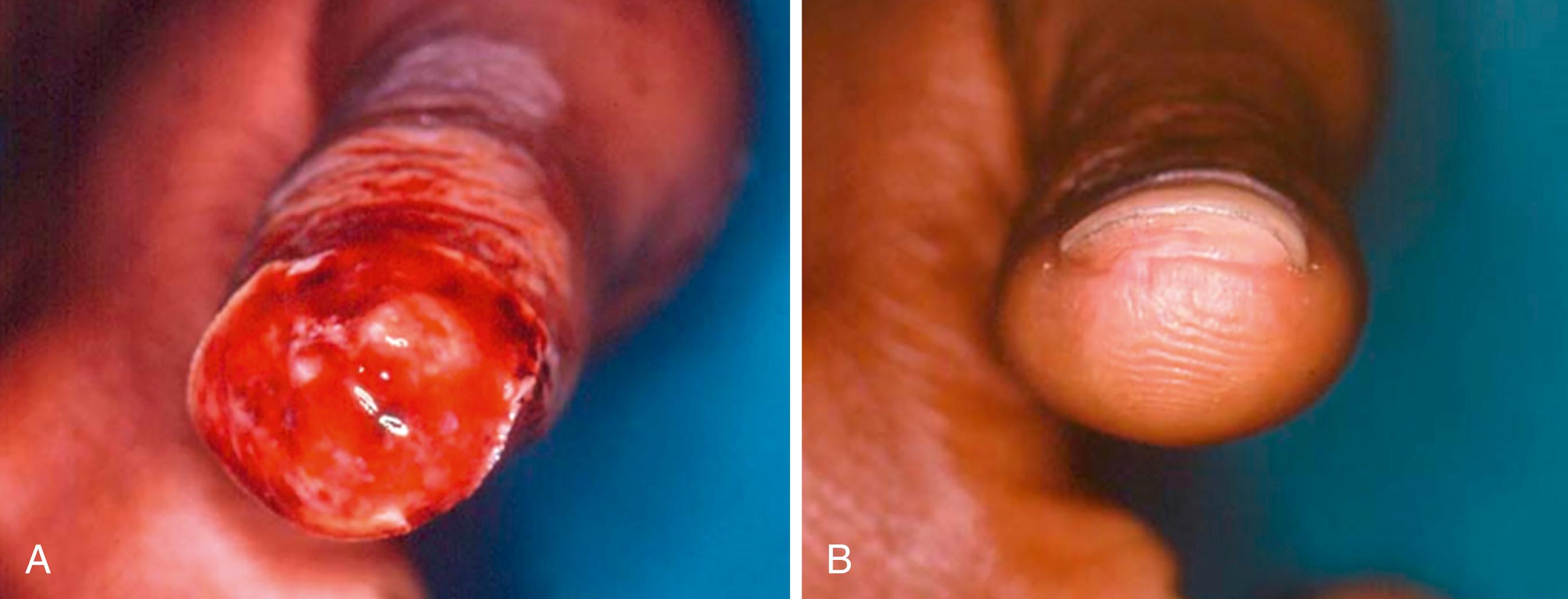
When a fracture is exposed in the wound, I will choose a flap for coverage. I will also opt for a flap for slightly larger pulp defects (transverse and proximal oblique amputations). In these instances, the classical Atasoy and Shepard flaps, , or modifications, and the Moberg flap all have a place. Choice is based more on preferences and the experience of the surgeon, since all flaps are equally effective.
Larger pulp defects (more than 50% of the pulp lost) may benefit from the Moberg flap, but the risk of flexion contracture is high. In my experience, only the Litter flap (“reconnecting” the nerve) is a reasonable alternative, but the potential damage done to the middle finger must be taken into account. My first choice in the fit individual (see below) is a peroneal hemipulp transfer (see Fig. 48.4 ). The procedure may at first glance seem excessive, but this alternative does not impair existing hand function, and with a busy microsurgical team the procedure can be performed without a lengthy operating time, with very low failure rates. The Litter flap is my first choice for patients not willing to undergo a complex microsurgical procedure.
The Brunelli and the Moschella flaps do not provide sensitive skin, and for this reason, except in older adults, they are not recommended for pulp loss. The dorsoradial flap is ideal for radial defects, while both are equally good for covering dorsal ones.
Amputations proximal to the sterile matrix will produce problems with nail adherence, which will cause painful lifting of the nail: this, in turn, will make the patient seek a definite solution. While total nail resection and a flap can be an alternative, partial toe is my preferred choice. Flap elevation can be accomplished in 30 to 40 minutes, and surprisingly the nail will grow uniformly (see Fig. 48.11 ).
In more proximal amputations, the classic teaching that patients compensate for the loss and do not have any functional impairment with amputation distal to the IP joint is, in my experience, a fallacy. These patients, in fact, perform poorly and are deeply concerned about the loss. For this reason, they are much better served by a customized hallux transfer, which yields high satisfaction and minimal donor site morbidity. , , In my practice, they are indicated not only for musicians and “delicate young ladies” but also for manual workers and for any patient willing to have a near perfect thumb and who understands the procedure. I do not make any distinction between people who smoke or drink, are overweight, have diabetes, or are older. My only proviso is that they can withstand the operation. Smokers are counseled on the negative effect of smoking as a trigger of spasm and vascular problems. They are advised to refrain from smoking in the immediate postoperative period, and usually they do well for a couple of weeks or less, but once they feel the critical period is over, they go back to their old ways. Despite this unselected population the probability of failure in my hands has been very low (3 cases in more than 500 toe-to-hand transfers performed by the author).
That being said, partial toe transfers are not for beginners. Apart from the need for familiarity with handling small vessels and anastomosis, to achieve good cosmetic results the dissection has to go to the tip of the hallux to reduce the bone in the sagittal and coronal planes, as the great toe is much larger than the thumb ( Fig. 48.15 ).
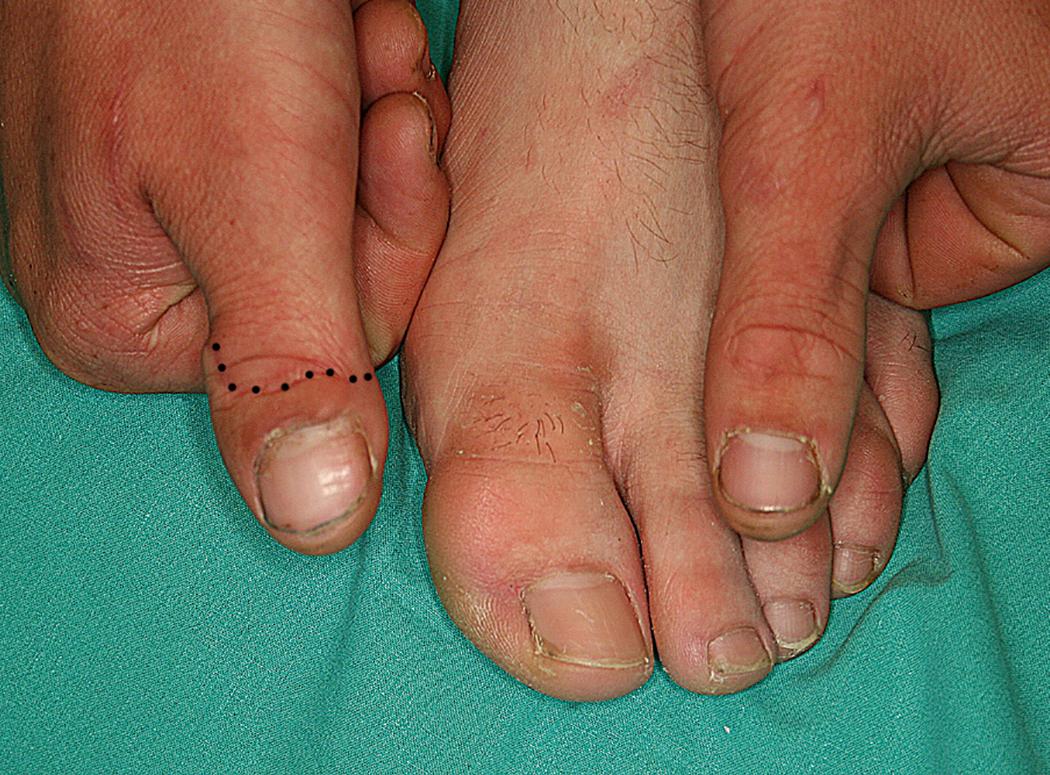
As a final caveat, I strongly recommend early transfer for distal amputation cases, not only for the sake of preserving exposed tissue but also for smooth and straightforward surgery. Furthermore, early coverage of the stump—with the toe—allows one to preserve structures without the need for temporary flaps. Contrarily, if the toe transfer is delayed, subsequent scarring will make dissection more difficult, tissue will prove unyielding, and, what is worse, the local arteries will tend to go into unremitting spasm.
Assuming that the thumb is covered by nonpainful sensitive skin, its length is the most crucial consideration: All efforts should be directed to restore as close to the normal length as possible (i.e., 0.5 cm proximal to the PIP joint of the index when set by the side). Length will directly affect the functional capabilities of the thumb to the point that at the metacarpal head thumb function will be totally absent (40% to 60% impairment of the hand).
There are several methods to reconstruct a thumb at this level, the most valuable are phalangization, bone lengthening, osteoplastic reconstruction, pollicization/on-top plasty, and toe transfer. The last has been discussed thoroughly in the previous chapter and will not be dealt with here. Others, such as the time-honored “cocked-hat” of Gillies, are out of the armamentarium in the current Internet era.
Phalangization consists of increasing the working length of the remaining thumb stump by deepening the first web. This is achieved by a combination of Z-plasty and the release of the fascia of the adductor and of the first dorsal interosseous ( Fig. 48.16 ). The lengthening effect can be increased further by releasing the first dorsal interosseus completely from the first metacarpal and transferring the insertion of the adductor more proximally on the metacarpal. How to design the Z-plasty will be discussed in detail in the online section.
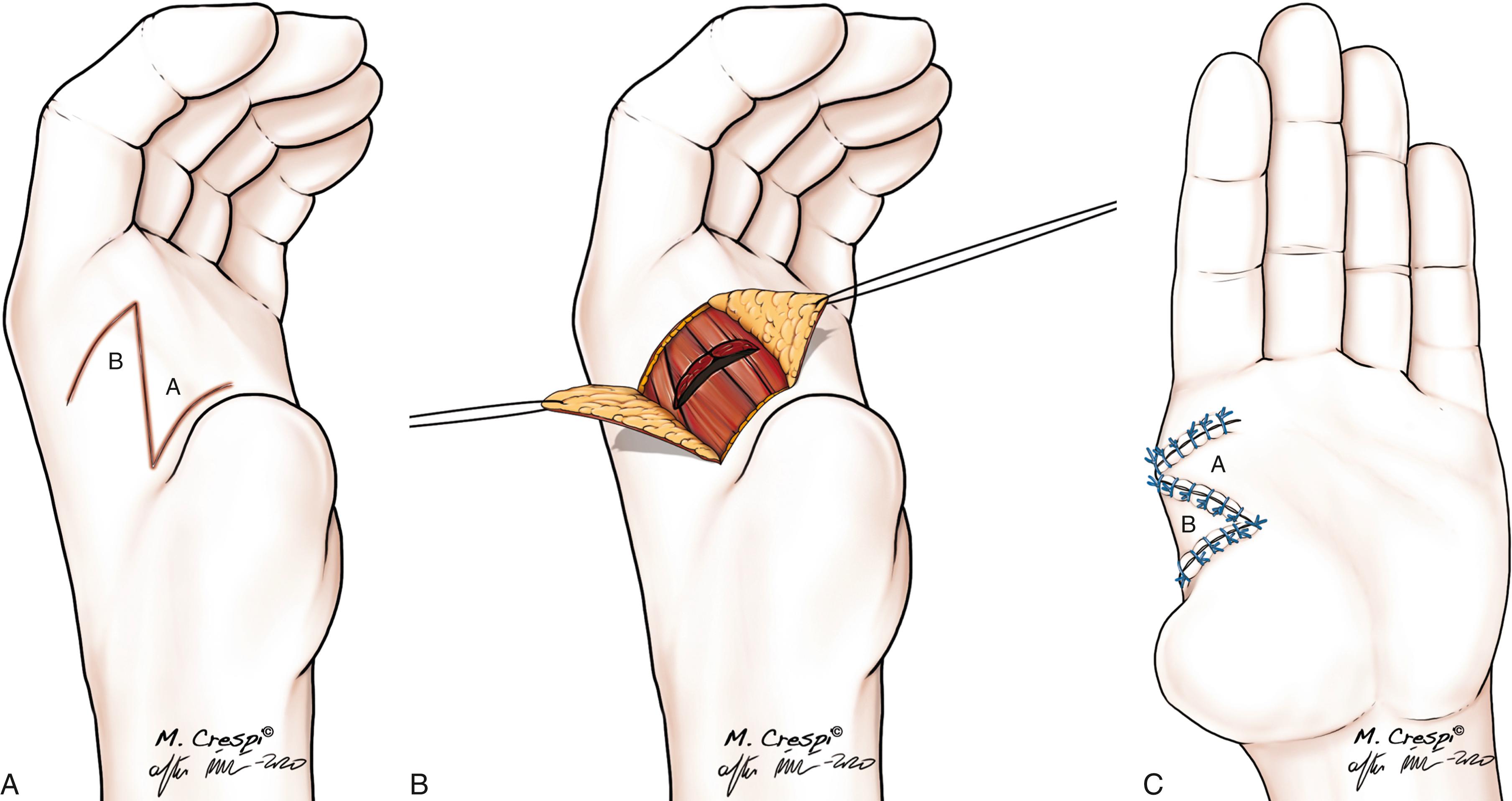
Currently, phalangization plays a minor role as a sole procedure and has been surpassed largely by other methods. Nevertheless, it still has a role in distal amputations (see Fig. 48.10 ) or combined with other lengthening methods, such as mini toe transfers or bone distraction.
Distraction of the first metacarpal was introduced by Ivan Matev in the late 1960s. , Initially only the first metacarpal was lengthened, but refinements to the technique and devices permitted its application for phalanges also. ,
The procedure of distraction osteogenesis (callotasis) uses the principle of slow distraction through an area of healing fracture callus. It requires, as prerequisites, a thumb stump with good coverage and patient understanding of the importance of daily care and accepting that the whole process may take about 3 to 4 months. Matev claimed that patients with two-thirds of the metacarpal would be eligible for the operation. However, taking into account that only about 3 cm of length can be obtained, the very best result in that scenario would be a ridiculous stump. Therefore only when the whole metacarpal, or better, a part of the proximal phalanx is present, should this procedure be considered.
After installation of the device, a transverse osteotomy is performed in the metacarpal. Seven days later, lengthening is begun at a rate of 1 mm/day. Once the desired length is achieved, a number of options are available: The gap can be filled with an iliac crest bone graft, , a bridging plate can be placed while the callus strengthens, or the device can be kept in place until bone forms in the gap ( Fig. 48.17 ). If a remnant of the proximal phalanx exists, the MCP joint should be pinned in extension during the whole process, as otherwise a flexion contracture of the proximal phalanx will occur.
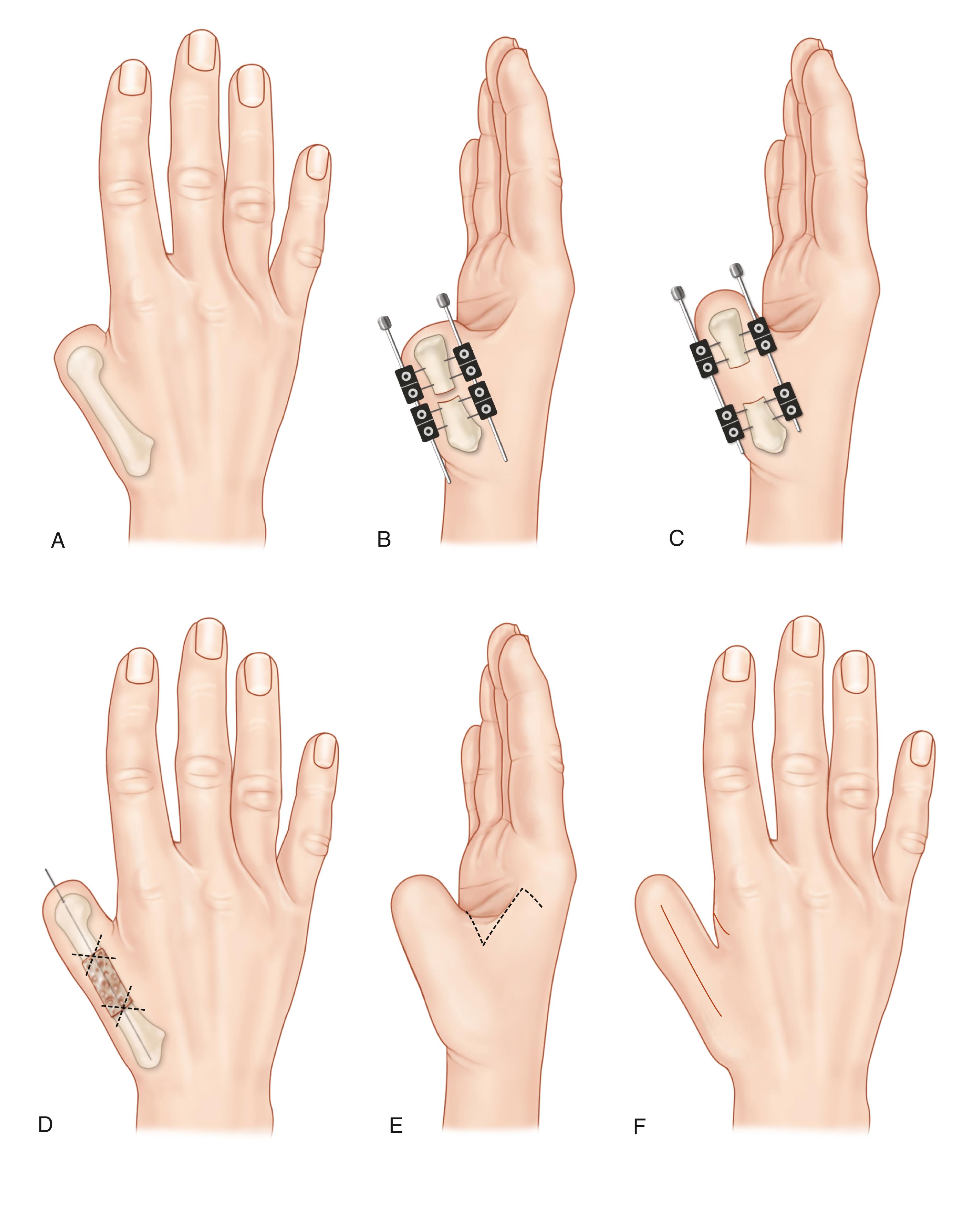
Bone distraction may be better than nothing, but the procedure at best procures a poor thumb replica with no nail, no pulp, and usually a thumb that is still too short. Furthermore, pain when pinching may be an issue (see Fig. 48.2 ). Last but not least, the patient should understand the procedure and the need for their cooperation to avoid complications. Pain at the carpometacarpal joint, secondary to pressure on the joint during the distraction, may require the process to be abandoned. As a matter of fact, early degeneration of this joint may be an issue in younger patients (see Fig. 48.23C , later).
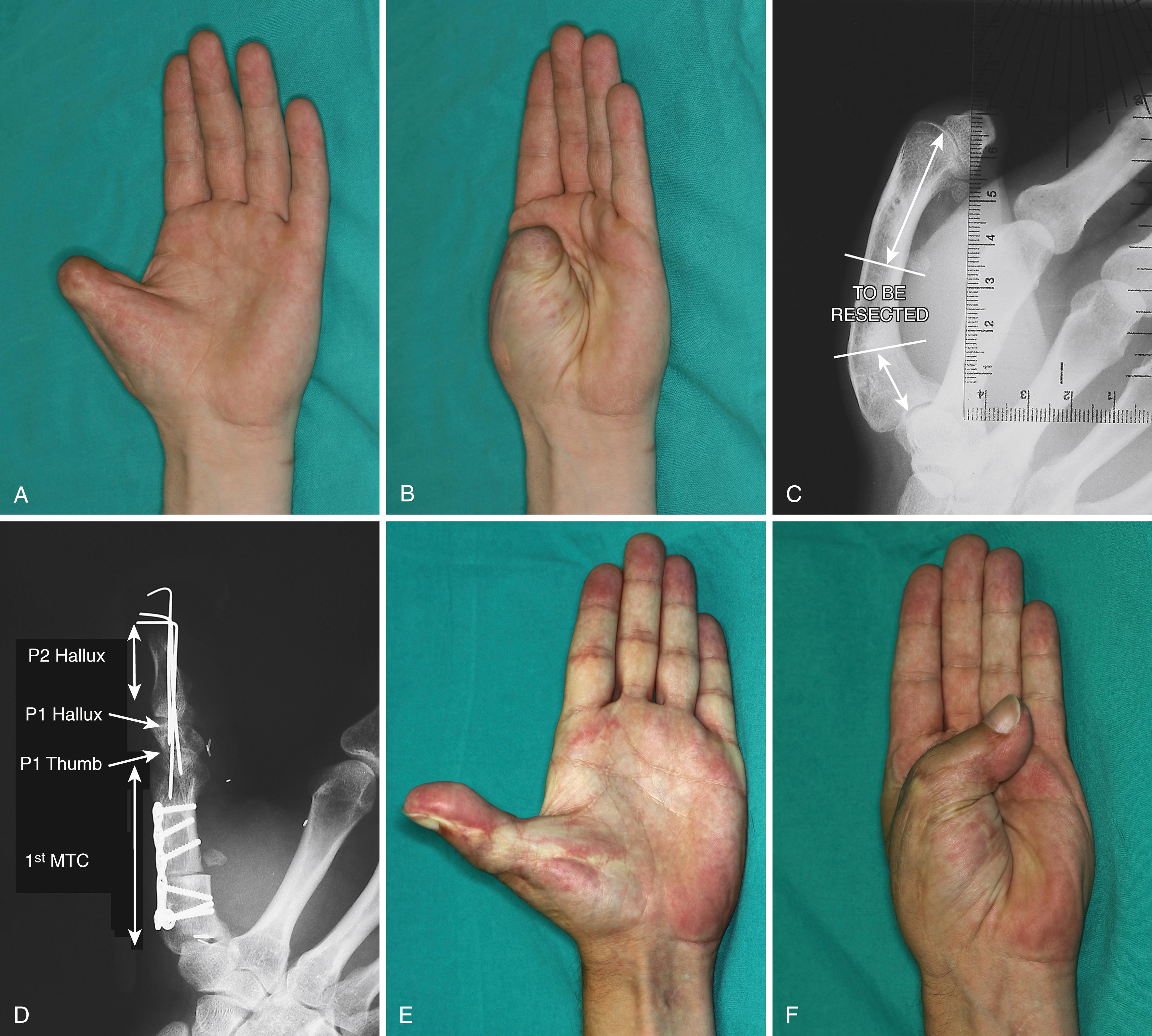
Despite these drawbacks, metacarpal lengthening has the advantage of retaining the native innervation and, apart from time, requires little effort on the patient’s part, except for a commitment to ensure pin care.
In summary, callotasis of the first metacarpal may be indicated in older individuals, as the procedure is easy and function may be improved. The paradox is that this age group, who may benefit the most, has the least bone-forming potential and the highest incidence of basal joint degeneration. Complications of bone healing and the need for additional grafting are thus the norm, prolonging an already protracted process. Furthermore, pain at the base of the thumb may force the procedure to be aborted.
Osteoplastic reconstruction was popular in the 20th century; however, today it is used less frequently. As primarily devised by Nicoladoni and others, , it consisted of covering a piece of bone graft along with a tubed flap, typically from the abdomen. The main problems were bone resorption and lack of sensibility. Successive improvements were added by several pioneers, such as using a tricortical bone graft from the iliac crest rigidly fixed to decrease the degree of resorption, using the groin flap, and adding a neurovascular flap to provide sensibility. The procedure is summarized in Fig. 48.18 , and the technical details of the operation (groin flap elevation) are discussed in Chapter 44 .
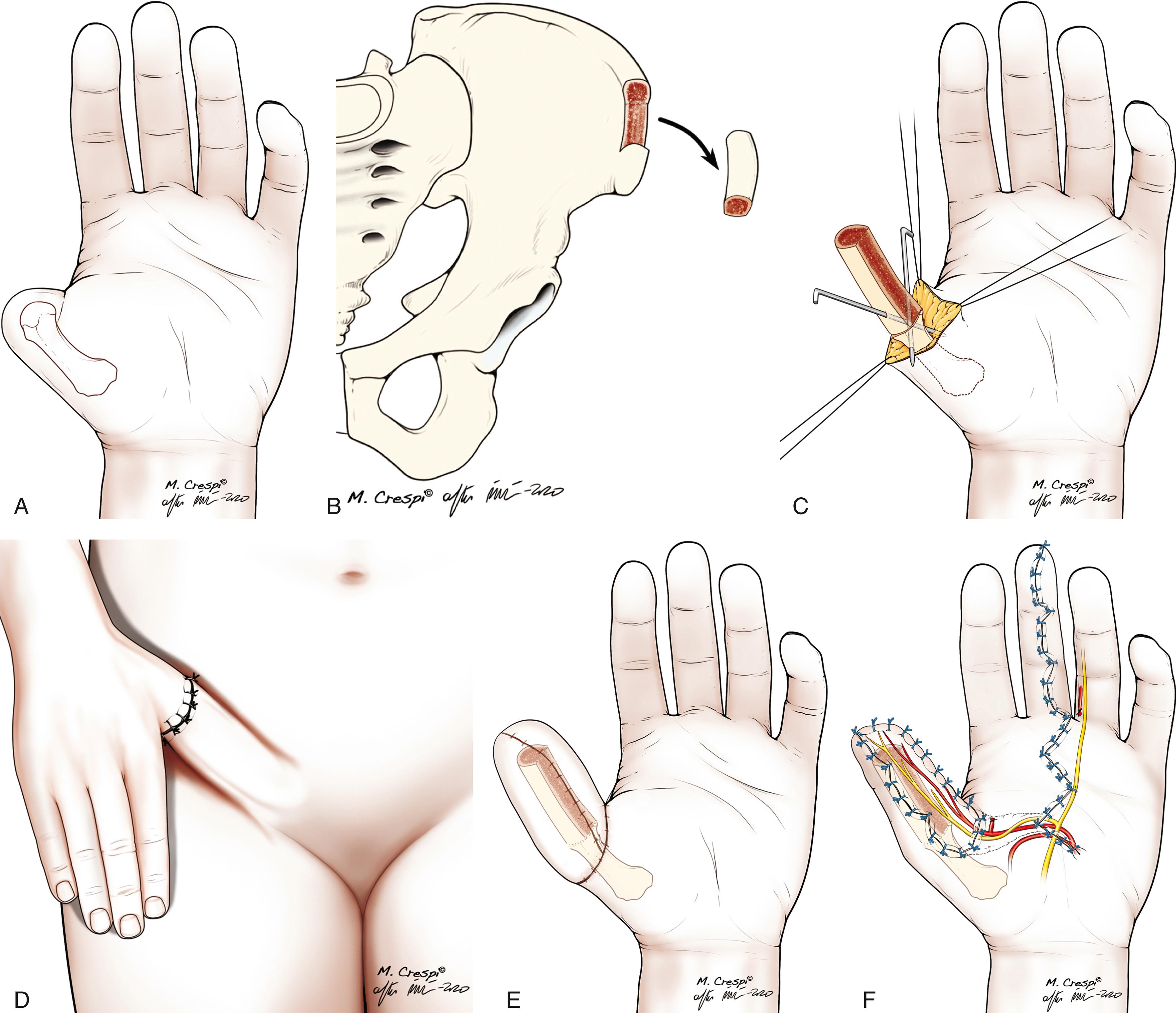
The procedure has the undeniable advantage of not sacrificing another finger, but it still had several drawbacks, among which are a long process, the need for two operative procedures, poor cosmesis, and cortical confusion related to the Littler flap. Even classic authors recommended that osteoplastic reconstruction be abandoned, owing to the poor results and the need for several operations. ,
The operation has a limited place in the armamentarium particularly if one adds the improvements to be discussed below. In order to shorten the lengthy process, Biemer and Stock and Foucher et al. independently published the feasibility of reconstructing the frame of the thumb by means of distally based radial forearm osteocutaneous flap. The sensibility was provided by connecting the forearm nerves to the ones in the thumb or by a Littler flap. Despite the payback of a shorter procedure, the quality of the reconstruction was pretty much the same as the classic osteoplastic approach. Furthermore, bone resorption of this marginally vascularized bone included in the flap was still an issue.
Lin et al. proposed a 21st-century osteoplastic reconstruction. In their technique an osteocutaneous flap pedicled from the groin was followed in a second stage by a toe transfer, thus reducing the need of more soft tissue and bone from the foot. In this way, resorption of bone moved in the first stage was no longer an issue, as it was attached to vascularized bone on both ends after transfer of the toe. However, the reconstruction was still lengthy, as even when using an osteocutaneous flap, a period of 3 to 6 months was allowed for the flap to mature and for the bone to heal before the toe could be transferred.
If the loss of the thumb was proximal to the metacarpal head, several authors have recommended transferring an intact finger to replace the thumb—the so-called pollicization. Littler introduced pollicization of the index as a neurovascular pedicle method of digital transposition in 1953. , He stressed that Gosset, from France, was perhaps the first to use the neurovascular pedicle finger transfer concept in 1949. Buck-Gramcko refined the technique of pollicization in congenital thumb hypoplasia. The technical details of the operation can be found in Chapter 37 ; however, there are some differences in the present scenario worth emphasizing. First of all, after trauma, it is not uncommon for muscles and skin to be scarred and useless. Both need to be replaced at the same time or prior to the procedure, as we will discuss later. Furthermore, excessive tendon length, secondary to the reposition, will not adapt as in the child. Repair of the proximal stump of the flexor profundus of the index to the flexor pollicis longus stump in the forearm should be done as a routine. In this group of patients where the saddle joint is preserved, the length of finger transferred should match a normal thumb ( Fig. 48.19 ).
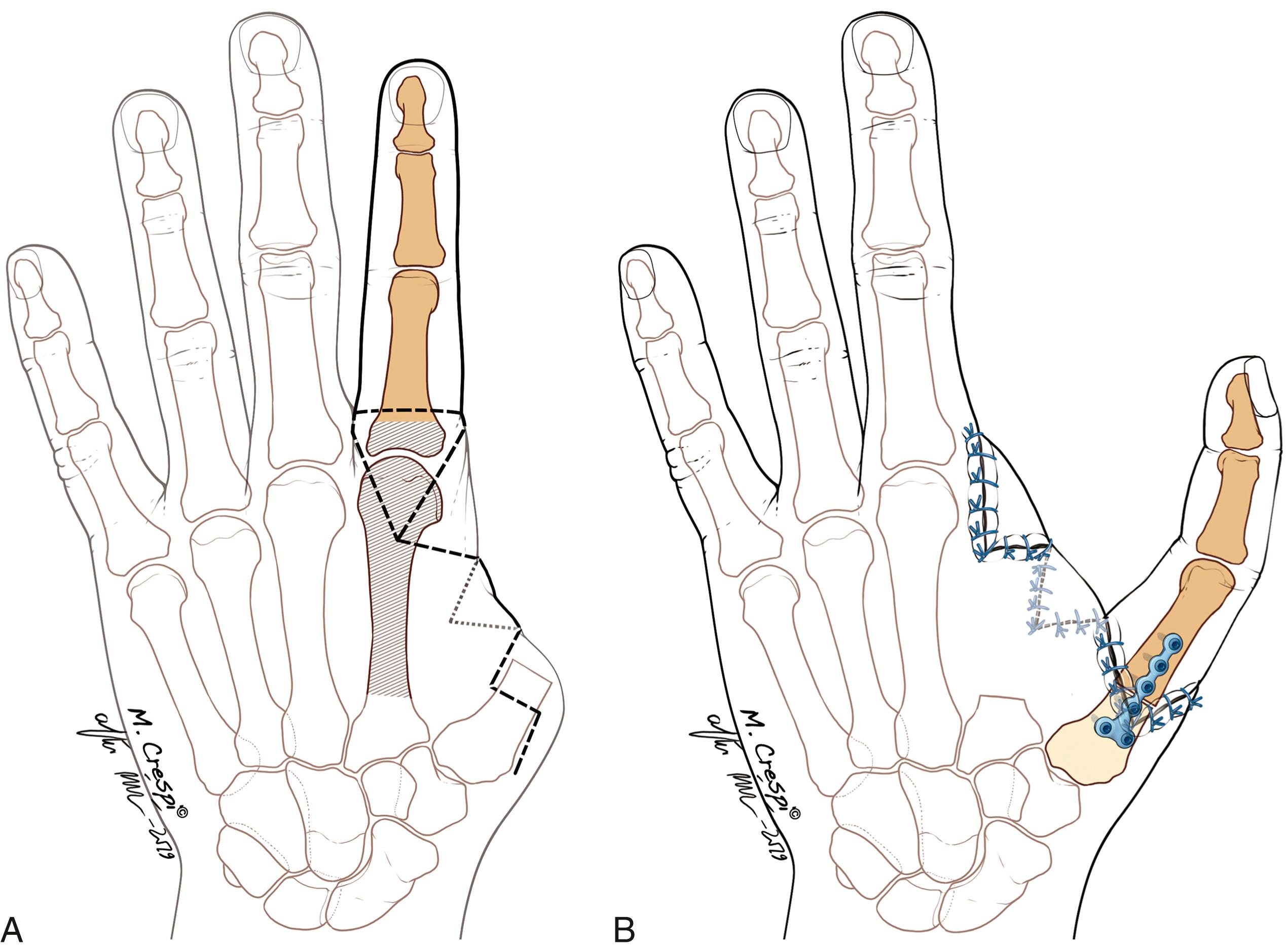
Hilgenfeldt, Gosset, and Brunelli recommended the ring or the middle finger as the donor for pollicization, arguing that removing the index will deprive the patient of performing fine pinch activities. , The discussion is somewhat outdated as the middle finger rapidly assumes its neo-index role. Most importantly, pollicization of a ring or middle finger is much more difficult and may jeopardize the transplant vascularization due to crossover of vessels and tendons. Hence, at this point in time, there is no place for such a transfer. Similarly, most authors would agree that pollicization is not indicated when there is more than the thumb missing. However, when there is an index stump available, based on the same principles of neurovascular finger transfer, Kelleher et al. introduced the so-called on-top plasty. In this operation, a portion of the damaged index is used to lengthen the short thumb. As an aside the procedure serves to increase the first web span as well. Good results have been reported. ,
Pollicization and on-top plasty are not indicated in cases of concomitant palmar trauma with suspected neurovascular injuries. In these instances, the procedure may be too risky, as, even if patent, the arteries may be damaged during the dissection, and a disastrous outcome can be anticipated if microsurgery capabilities are not available. Admittedly, one could transfer the index based on a dorsal skin pedicle, much as Nicoladoni used to do in the late 18th century. However, the result would be no more than an insensitive post.
While pollicizing an intact ring or middle finger is an unwise operation, the same cannot be said for a stump in the same location. Not only will this stump help rebuild the thumb, but a hindrance to hand function will be removed. Furthermore, the procedure adds length to the thumb and can also restore motion at the MCP joint if this is missing.
The technique of pollicization of any finger or on-top plasty follows very similar steps; however, while the neurovascular structures fall into place for the index (see Chapter 37 ), dangerous crossovers will occur when transferring any other stump. To prevent that from occurring several steps should be taken. The more complex central stump on-top plasty is described here, and slight modifications should be made for any other case ( Fig. 48.20 ).
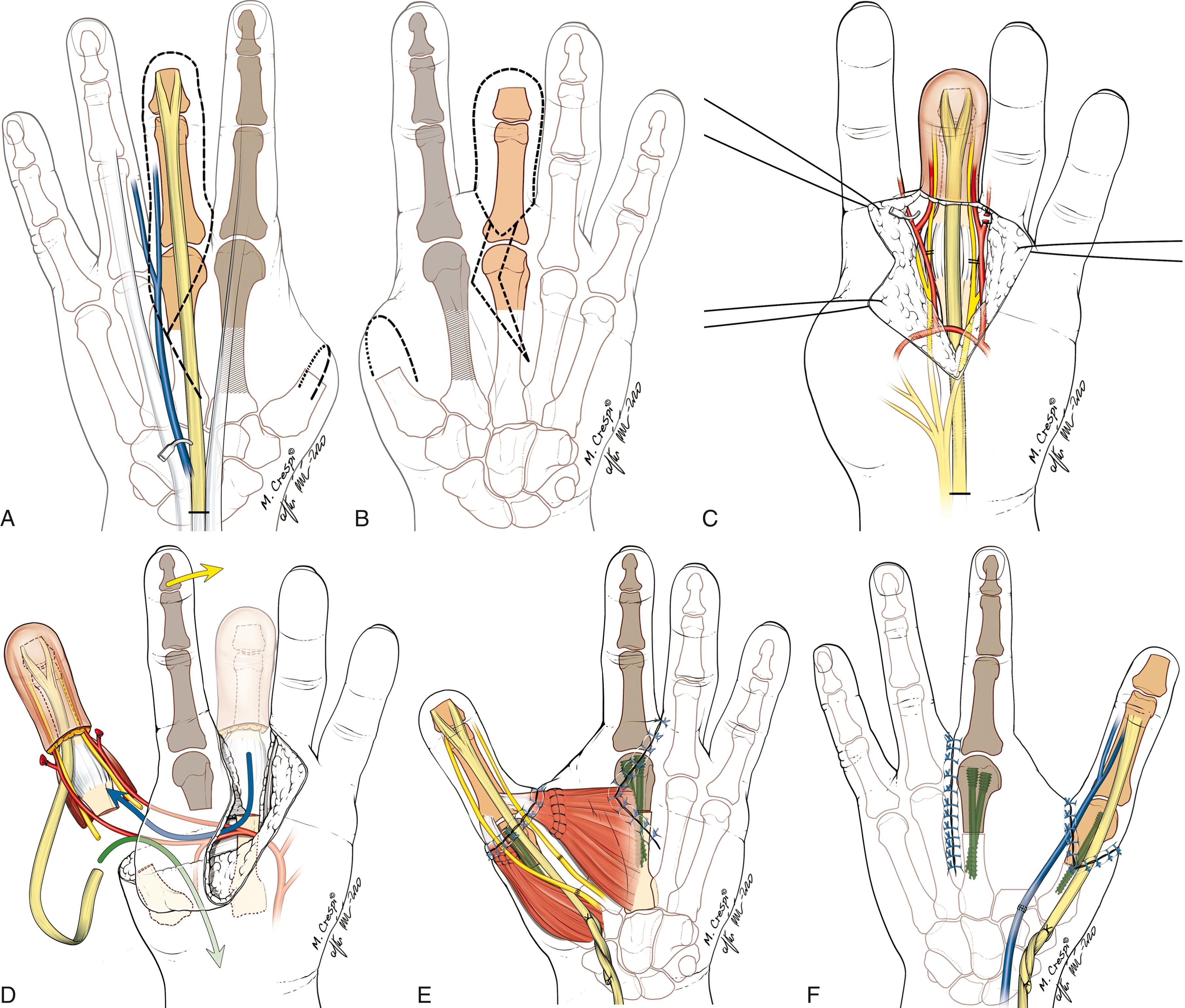
Become a Clinical Tree membership for Full access and enjoy Unlimited articles
If you are a member. Log in here